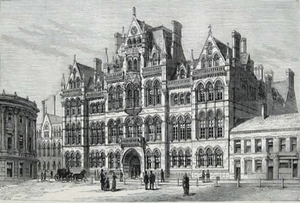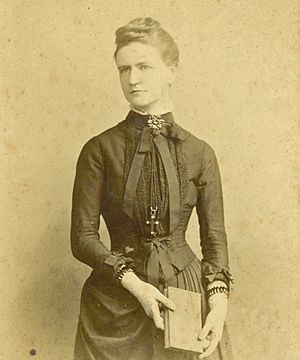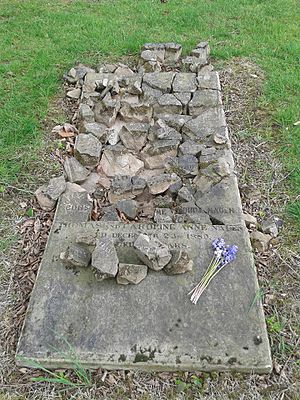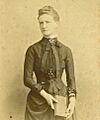Constance Naden facts for kids
Quick facts for kids
Constance Naden
|
|
|---|---|
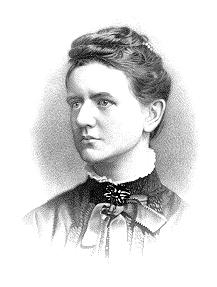
Constance Naden
|
|
| Born | 24 January 1858 15 Francis Road, Edgbaston, Birmingham, England |
| Died | 23 December 1889 (aged 31) |
| Resting place | Key Hill Cemetery, Birmingham |
| Occupation | Writer, poet and philosopher |
| Nationality | English |
| Education | Birmingham and Midland Institute |
| Alma mater | Mason Science College |
| Notable works | Songs and Sonnets of Springtime |
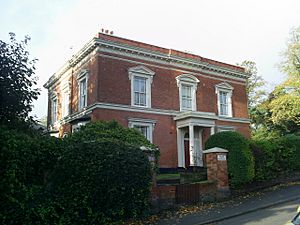
Constance Caroline Woodhill Naden (born January 24, 1858 – died December 23, 1889) was a talented English writer, poet, and thinker. She spent her life studying and writing about big ideas like philosophy and science. She also published two books of poetry. Even though she died very young at 31, her work was so important that more of her writings were published after her death.
To honor her, a man named Robert Lewins created the Constance Naden Medal. He also had a statue (called a bust) of her placed at Mason Science College, which is now the University of Birmingham. A famous British leader, William Ewart Gladstone, even said she was one of the best female poets of her time.
Contents
Constance Naden's Early Life
Constance Naden was born in Edgbaston, Birmingham, England, on January 24, 1858. Sadly, her mother passed away just two weeks after Constance was born. Her father, Thomas Naden, was an architect. Constance was raised by her mother's parents, Caroline and Josiah Woodhill, from when she was just 12 days old.
Her grandparents lived in Pakenham House in Edgbaston. They were very religious and loved to read. When Constance was eight, she went to a local school where she discovered a talent for painting. One of her paintings was even shown at an art exhibition in 1878.
Constance Naden's Education
Constance became very interested in big subjects like philosophy, languages, and science. In 1879, she studied botany (the study of plants) and French at the Birmingham and Midland Institute.
From 1881 to 1887, she attended Mason Science College. There, she learned about physics, geology, chemistry, and zoology (the study of animals). She also joined the Birmingham Natural History Society. Constance even helped edit the college's magazine. She was a very bright student and won awards for her essays on geology and logic.
Constance Naden's Philosophy
In the late 1870s, Constance Naden worked with a doctor named Robert Lewins to create her own philosophy called Hylo-Idealism. They wrote letters to each other about it for the rest of her life.
The main idea of Hylo-Idealism is that "Man is the maker of his own Cosmos." This means that our minds create our own world. Everything we see and feel, even solid objects, exists because our minds make sense of them.
Constance wrote many essays explaining her ideas. These were published in science magazines and other journals. She sometimes used different names like "C.N." or "Constance Arden" for her writings. She was also interested in the ideas of Herbert Spencer, another famous thinker. Spencer believed that society, like living things, changes and grows more complex over time.
Constance Naden's Poetry
In 1881, Constance Naden published her first book of poems called Songs and Sonnets of Springtime. This book has many different types of poems. Her series of sonnets (a type of poem) that describe the changing seasons is especially well-known.
Constance Naden's Later Life
In 1887, Constance inherited a lot of money after her grandmother passed away. This allowed her to travel to places like Istanbul, Palestine, India, and Egypt. She traveled with her friend, Madeline Daniell, who worked to help women get higher education.
When she returned to England in 1888, Constance bought a house in London. She shared it with Madeline. She helped raise money so that women in India could study medicine. She also joined groups that worked for good causes, including the National Indian Association. Constance was a strong supporter of women's right to vote, and she spoke about it at public events.
People described Constance as being "slight and tall" with "clear blue-grey eyes." She was active and spoke clearly in public. Even though she could be sarcastic in debates, her friends loved her very much. One friend, Professor Charles Lapworth, wrote that he saw her as a "sympathetic fellow-worker" and that her early death meant he lost "one of the best and dearest of my personal friends."
Constance Naden's Illness and Death
In 1889, Constance needed surgery for an infection. She had the operation on December 5, but sadly, she died from a related infection on December 23. Her last letter to Robert Lewins talked about her worries about the surgery. She was buried in Key Hill Cemetery in Birmingham.
Her gravestone was damaged over the years. In 2017, a campaign started to replace it with a new memorial. A special ceremony was held on May 11, 2019, to dedicate her new gravestone.
Constance Naden's Remembrance
After her death, Constance Naden was praised for her philosophical writings and her poetry. Robert Lewins and William Ewart Gladstone both spoke highly of her work. Herbert Spencer, who influenced her ideas, said she had a rare mix of "high philosophical capacity with extensive acquisition." He believed her death was a "serious loss" to thoughtful ideas.
Robert Lewins created the Constance Naden Medal at Mason College in her honor. This medal is still given out each year for excellent academic work. Lewins also had a statue (bust) of Constance made and gave it to Mason College. It sits on a base shaped like three books, with the titles of her works written on them. Today, the bust is in the Cadbury Research Library Reading Room at the University of Birmingham.
On December 14, 2009, a blue plaque was placed on her childhood home, Pakenham House, in Edgbaston. The plaque says: "Constance C.W. Naden 1858–1889 Poet, Scientist and Philosopher lived here for most of her life."
Constance's grave in Key Hill Cemetery is shared with her mother and grandparents. The original gravestone was damaged, but thanks to a fundraising effort, a new one was installed in 2019. The new stone has the original words and also highlights her achievements as a "Poet, philosopher, artist, Scientist." It also includes a line from one of her poems: "For earth is not as though thou ne’er hadst been."
Constance Naden's Posthumous Publications
After her death, three more books of Constance Naden's work were published:
- Induction and deduction, and other essays (1890)
- Further Reliques of Constance Naden (1891)
- The Complete Poetical Works of Constance Naden (1894)
Images for kids
-
Naden's grandparents' home, Pakenham House, 20 Charlotte Road, Edgbaston, Birmingham


